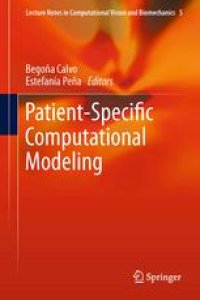
Ebook: Patient-Specific Computational Modeling
- Tags: Biomedical Engineering, Theoretical and Applied Mechanics, Health Informatics, Imaging / Radiology
- Series: Lecture Notes in Computational Vision and Biomechanics 5
- Year: 2012
- Publisher: Springer Netherlands
- Edition: 1
- Language: English
- pdf
This book addresses patient-specific modeling. It integrates computational modeling, experimental procedures, imagine clinical segmentation and mesh generation with the finite element method (FEM) to solve problems in computational biomedicine and bioengineering. Specific areas of interest include cardiovascular problems, ocular and muscular systems and soft tissue modeling. Patient-specific modeling has been the subject of serious research over the last seven years and interest in the area is continually growing and this area is expected to further develop in the near future.
This book addresses patient-specific modeling. It integrates computational modeling, experimental procedures, imagine clinical segmentation and mesh generation with the finite element method (FEM) to solve problems in computational biomedicine and bioengineering. Specific areas of interest include cardiovascular problems, ocular and muscular systems and soft tissue modeling. Patient-specific modeling has been the subject of serious research over the last seven years and interest in the area is continually growing and this area is expected to further develop in the near future.
This book addresses patient-specific modeling. It integrates computational modeling, experimental procedures, imagine clinical segmentation and mesh generation with the finite element method (FEM) to solve problems in computational biomedicine and bioengineering. Specific areas of interest include cardiovascular problems, ocular and muscular systems and soft tissue modeling. Patient-specific modeling has been the subject of serious research over the last seven years and interest in the area is continually growing and this area is expected to further develop in the near future.
Content:
Front Matter....Pages I-VII
Bringing Vascular Biomechanics into Clinical Practice. Simulation-Based Decisions for Elective Abdominal Aortic Aneurysms Repair....Pages 1-37
A Subject-Specific Framework to Inform Musculoskeletal Modeling: Outcomes from the IUPS Physiome Project....Pages 39-60
Patient Specific Computational Modeling in Cardiovascular Mechanics....Pages 61-79
Modeling the Human Heart Under Acute Ischemia....Pages 81-103
Detailing Patient Specific Modeling to Aid Clinical Decision-Making....Pages 105-131
Computational Analysis of Flow and Stress Patterns in Patient Specific Thoracic Aortic Aneurysm Models....Pages 133-159
Patient-Specific Biomechanical Framework for Aiding Clinical Decisions in Eye Surgery....Pages 161-193
This book addresses patient-specific modeling. It integrates computational modeling, experimental procedures, imagine clinical segmentation and mesh generation with the finite element method (FEM) to solve problems in computational biomedicine and bioengineering. Specific areas of interest include cardiovascular problems, ocular and muscular systems and soft tissue modeling. Patient-specific modeling has been the subject of serious research over the last seven years and interest in the area is continually growing and this area is expected to further develop in the near future.
Content:
Front Matter....Pages I-VII
Bringing Vascular Biomechanics into Clinical Practice. Simulation-Based Decisions for Elective Abdominal Aortic Aneurysms Repair....Pages 1-37
A Subject-Specific Framework to Inform Musculoskeletal Modeling: Outcomes from the IUPS Physiome Project....Pages 39-60
Patient Specific Computational Modeling in Cardiovascular Mechanics....Pages 61-79
Modeling the Human Heart Under Acute Ischemia....Pages 81-103
Detailing Patient Specific Modeling to Aid Clinical Decision-Making....Pages 105-131
Computational Analysis of Flow and Stress Patterns in Patient Specific Thoracic Aortic Aneurysm Models....Pages 133-159
Patient-Specific Biomechanical Framework for Aiding Clinical Decisions in Eye Surgery....Pages 161-193
....